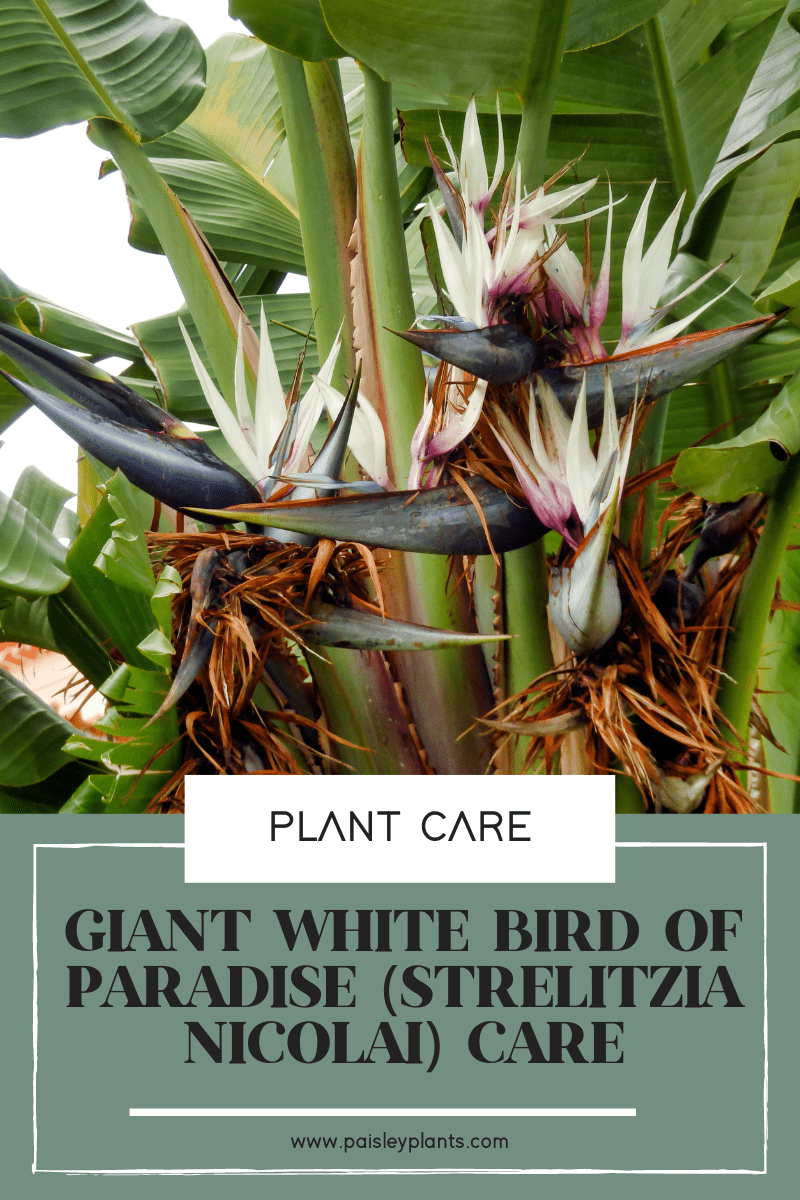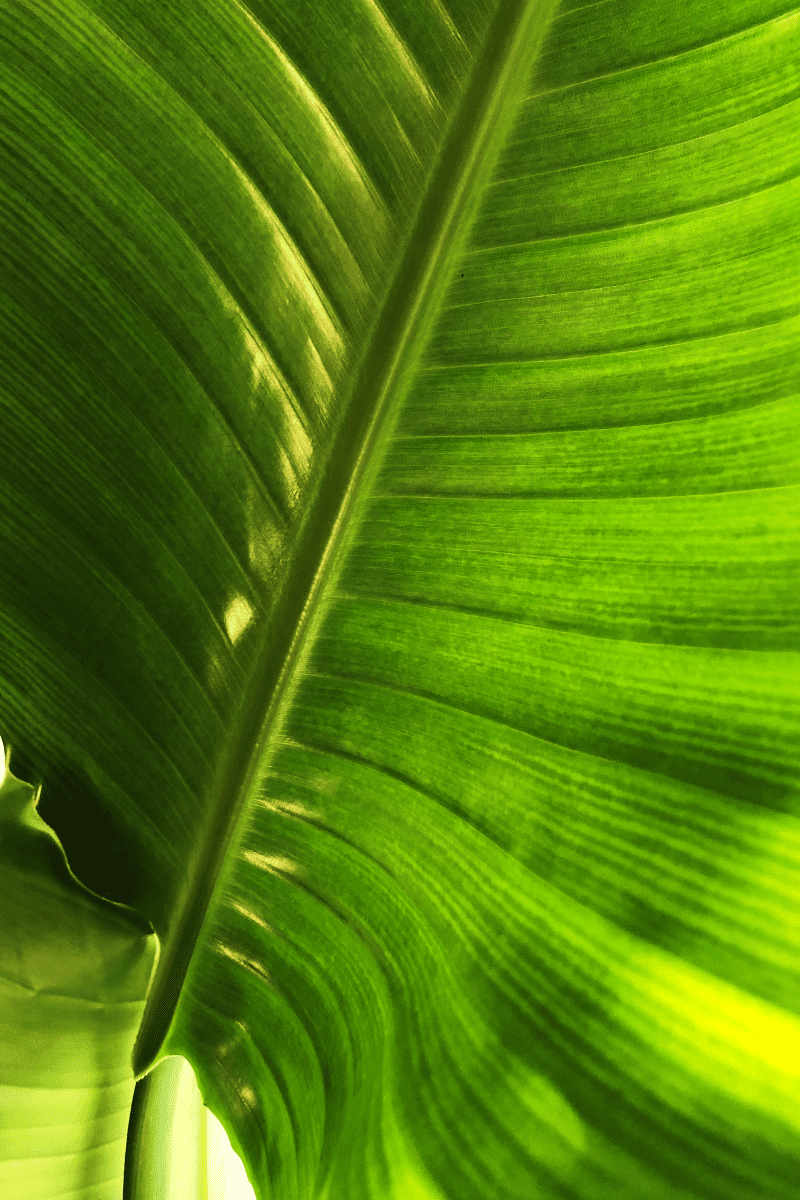Looking for care tips on how to grow the Giant White Bird of a Paradise, an amazing plant with huge leaves that’s part of the Bird of Paradise species? Keep reading and we’ll share all that you need to know!
A couple years ago, we had the privilege of spending a day at Longwood Gardens in Kennett Square, Pennsylvania. Wow! Wow! Wow! If you ever get the chance to go, take it! You could definitely spend days at that place. Such beauty that you cannot capture it in pictures!
Longwood Gardens is a botanical garden that consists of over 1,077 acres of gardens, woodlands and meadows. It is open year round to visitors that come from all over the world. There are both native and exotic plants to view.
Table of Contents
Giant White Bird of Paradise Strelitzia nicolai Background

This post includes affiliate links.
As we came around one of the many displays of plants that day, I laid eyes on a very unique flower I had never seen before. I looked at the description tag and it said it was a Bird of Paradise! I had never seen one until then and it took my breath away!
The flowers on these plants actually look like a bird with a beak and a plume on top of its head! It’s remarkable! You might think the same thing the first time you see one.
This beautiful plant is commonly known as the Wild Banana or Giant White Bird of Paradise. It is a native of South Africa, but has also been grown in Florida, California and other locations as an outdoor plant.
Lucky for us, it also can grow well as an indoor plant! Give it enough bright light and it will do just fine inside.
The Giant White Bird of Paradise, a native of South Africa, is considerably larger than the traditional Bird of Paradise plant. The flowers closely resemble those of the traditional Bird of Paradise, but this plant has white flowers forming the crown and have a bluish-purple tongue.
Toxicity
This plant is considered mildly toxic to humans. It can cause gastrointestinal effects including vomiting and diarrhea in humans, but especially small children. It would be best to keep it out of reach of your kids, if you do own one of these plants.
As far as pets go, it is also toxic to them. Keep it away from your pets and you should be good. The flower seeds contain toxic elements, so be sure your animals do not ingest any part of the plant!
Care Tips for Your Giant White Bird of Paradise

Water
The watering needs for this plant will vary depending on where the plant is placed, the humidity level, the time of year, and what the temperature is where it is growing.
Using distilled water is advised to prevent the buildup of minerals that can cause the plant’s leaves from turning brown along the edges. It is also advised to pour the water slowly around the base of the plant so it takes the water slowly.
This will help the water to filter down to the root zone and not run right out of the drainage holes in the bottom of the pot. This allows for a more even watering for the plant.
You can also take a pencil or a chopstick and poke holes into the soil to allow for drainage holes that the water can filter down through. This will also help ensure more even watering for your plant.
Light
Bright, indirect sunlight or partial shade is best for these Bird of Paradise plants. Be sure that it does not sit under direct sunlight for any length of time. Full sun will burn the banana-like leaves and you don’t want that!
You want to ensure it gets several hours (6 – 8) of bright, indirect sunlight each day. Your plant will grow in the direction of the light, so you may also want to be sure to rotate your plant once in a while so it does not bend towards the light.
Soil
You should use well draining soil that can dry out somewhat between waterings. Don’t use soil that doesn’t drain well. Remember that the soil you use will also add nutrients to your plant. You want to be sure to have good soil to maintain a healthy plant!
Fertilizer
It is a good idea to fertilize your plant once a month during the growing season, or early spring and the early fall. Don’t overfertilize it, though, since this can lead to excess salt buildup in the soil, leading to leaf burning. Remember – healthy soil helps to have healthy plants!
Temperature
The optimal temperatures for the Giant White Bird of Paradise are between 65 and 80 degrees F. Be sure, however, to keep it away from any direct drafts from heating or air conditioning vents.
Humidity
Like most tropical plants, this plant likes high humidity but can do okay in regular humidity levels of your home. Occasional misting will help the humidity conditions for this plant. This also helps remove dust particles from its leaves.
You can also use a microfiber cloth to remove any dust from the large leaves. This will help the growth since the plant receives oxygen from the photosynthesis that takes place through the leaves.
Pests and Diseases
There are not too many problems as far as pests and diseases with this plant. They can have root rot if they are overwatered but this is obviously easy to treat by not overwatering your plant!
They can be subject to mealybugs, scale, bacterial wilt and leaf blight also. You can easily wash the tiny mealybugs and scale away with water. You might need to use insecticidal soap and water or neem oil to keep them away if the infestation is too great.
Leaf blight causes white spots on the leaves with a green spot around the spot. This is most easily prevented with the application of a fungicide to the soil around the plant.
Bacterial wilt causes leaves to turn light green, wilt and die and is easily prevented with well draining soil and fungicide.
Keeping your plant watered properly and giving it proper light go a long way to having a healthy plant overall!
Pruning
If your plant has brown, yellow, diseased, damaged or dead leaves on it, you should definitely remove them! No one wants an ugly plant around.
This will definitely help the plant grow better also. If nothing else, the visual appearance of the plant will be much better because you trimmed away the flotsam!
It will also prevent any diseases from attaching and forming on your plant. Dead foliage can give place to different pests and diseases, so it is always best to remove it as soon as you see it.
Repotting
Due to the large size of this plant, it is best to only repot it once every two years or so or when it outgrows its current pot.
They actually don’t mind being a bit rootbound. You will want to choose a pot that is at least 2-4 inches larger than the current pot.
Propagation
Root division is the easiest way to propagate a Giant White Bird of Paradise. Once you do this, however, it may take as long as 10 years for new flowers to produce on the new plant! The flowers will definitely be worth waiting for!
Common Problems
There are a few common problems for your Giant Bird of Paradise plant that we can discuss here. One of them is that the leaves may split over time.
This is not an uncommon thing and is not something to worry about. It is part of the normal growth of this plant. When they’re kept outside and sort of strong winds can easily split the leaves, especially older leaves on a mature plant.
Another common problem is brown edges on the leaves. This can be due to underwatering your plant. Keeping a regular watering schedule can help prevent this from happening.
Yellowing leaves can also occur and is most likely due to overwatering your plant. As mentioned above, keeping a regular watering schedule will go a long way to keeping a healthy and happy plant!
How often should I water my Giant White Bird of Paradise?
Depending on where you grow your plant, you should water it every 1-2 weeks. If you have it in a warmer and sunnier place than normal, it may need to be watered more often. Keep a close eye on the soil moisture levels and water accordingly.
Yes, you can plant your Giant White Bird of Paradise indoors! It will need to have the right light, humidity and proper care, but it will definitely add some bold tropical flair to any indoor space!
Growing this kind of plant indoors requires a lot of sunlight in order for it to bloom. Unless you have at least six hours of sun per day, including some direct sunlight. Insufficient sunlight is the main reason that a Bird of Paradise doesn’t bloom.
In Conclusion
As I mentioned previously, if you ever get the opportunity to visit Longwood Gardens in Pennsylvania, take it! You won’t regret visiting there and seeing what it has to offer. It will be something you won’t soon forget!
If you have a beautiful sunroom or a greenhouse at your disposal, this would be a great place to have a Giant White Bird of Paradise plant. They require a lot of light to bloom and will also take up quite a bit of space to grow indoors.
If you are able to and have the right conditions, this is a perfect plant to keep in an outdoor space. The beauty and uniqueness of this tropical plant will always be a showstopper for you and your plant loving friends! Keep on growing!
